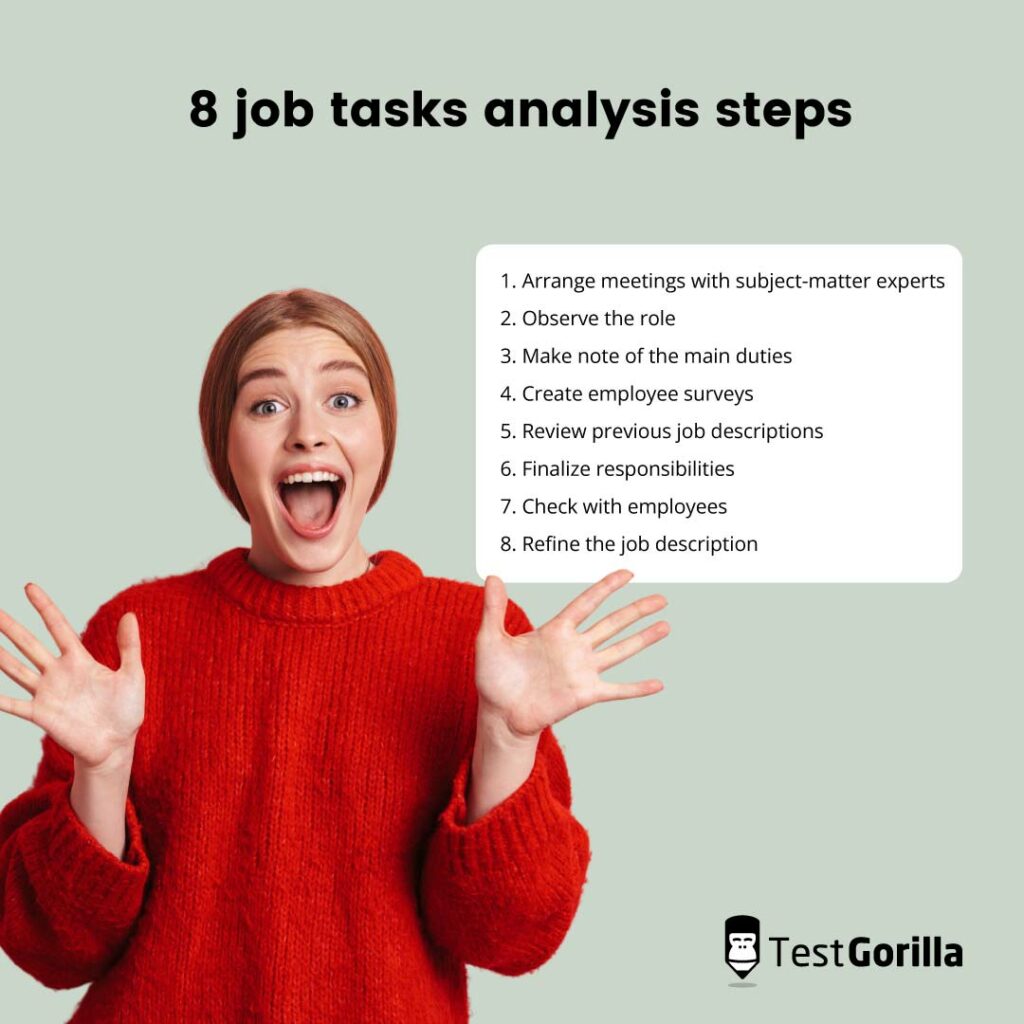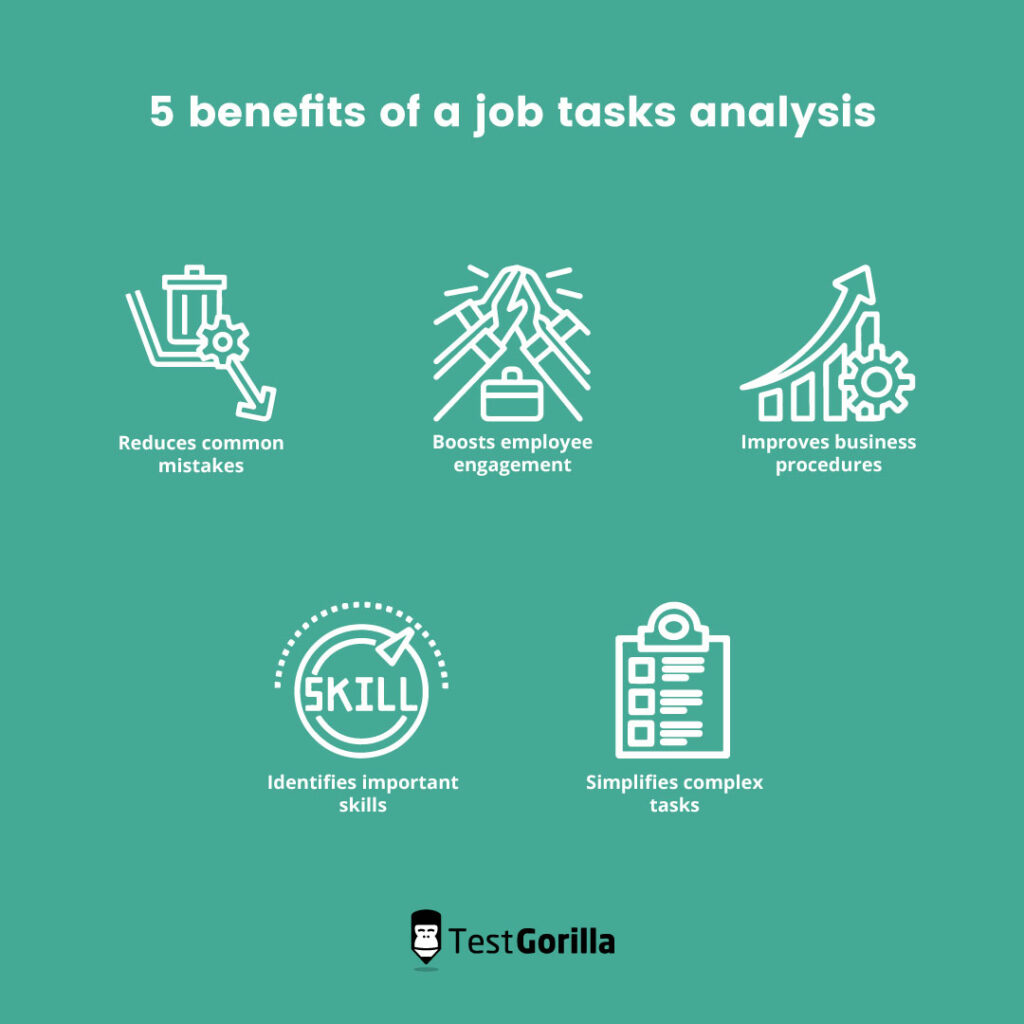8 simple steps for conducting a successful job tasks analysis
Many companies write basic descriptions of their job roles, but these don’t provide enough information. A general overview doesn’t give employers and candidates a fair benchmark in terms of promotion, salary, main responsibilities, and skills gaps.
You need to conduct a job tasks analysis if you want to stand out. Digging deeper into each role ensures you identify its key responsibilities and knowledge requirements. Do candidates know exactly what they’re applying for? Are they aware of your preferences?
Keep reading to discover eight steps for conducting a job tasks analysis with a comprehensive example you can follow.
Table of contents
What is a job tasks analysis?
A job tasks analysis defines the requirements and duties of a specific role. It can help you determine a position’s main responsibilities when writing a job description. Candidates should know exactly what they’re applying for when coming across the open position.
Nearly half (49%) of job seekers end up turning down job offers when they have a bad candidate experience. Further, 71% of candidates share their negative candidate experiences with their inner circle.
Although many different factors can affect the candidate experience, one issue can be badly written and inaccurate job descriptions that lead to applicants’ expectations being different from the reality of the role.
Candidates want to know about tasks, work environments, special equipment, relationships, and the required level of expertise in detail. The best tool you can use to ensure you provide them with this information is a job tasks analysis.
Some important steps in a job analysis include breaking the job down into smaller components, collecting data, and then analyzing the information to establish the required talents and skills.
Why is a job tasks analysis important?
A job tasks analysis is important because it improves productivity and employee engagement by clarifying the role’s tasks and responsibilities. It also enables a candidate to enter the role with more confidence. If you don’t have comprehensive job descriptions, candidates are more likely to turn away.
You can use data from the analysis to:
Write accurate job postings
Improve candidate tracking
Create employee skill development plans
Evaluate safety measures and violations
Conduct more performance reviews
Conducting a job tasks analysis can also complement skills-based hiring. This is great for finding top talent who could work well with your existing team to improve your current processes. For example, you might include details about technical-based tasks that require knowledge of computer networks and programming skills.
Keep in mind that 43% of job descriptions don’t accurately reflect the role. This can negatively affect turnover since candidates are more likely to leave a job if it isn’t what they imagined when first applying.
8 job tasks analysis steps
Here is a list of the steps to perform as a part of a job analysis. Each role is different, so you need to complete a separate analysis for all jobs you are advertising for. This may seem like a chore, but once you have analyzed each role, you can keep and update the documents with your findings for future use.
1. Arrange meetings with subject-matter experts
A subject-matter expert (SME) is someone who has extensive knowledge and experience in a role. They understand the best practices for performing their main responsibilities efficiently and safely. Your SME might already be in the role or have progressed into a more senior position because of their personal career growth.
You can create a list of potential SMEs when conducting research for your job task analysis. Consider employees who have extensive experience in the role and will give you the best feedback and job information.
2. Observe the role
Observing the role yourself is the next important step. You could shadow employees for the day or even attend online meetings to witness certain discussions. What tasks do they have to complete? Are they doing anything new to progress their skills?
Interacting with employees carrying out this role can help you gather more accurate information for writing job descriptions. Ask lots of questions, but be sure to let your staff know that you’re doing a job analysis and not there to criticize how they carry out their duties.
For example, you notice an employee arranging documents. They were hired to work on your blockchain project, and that task isn’t one of the responsibilities listed in their blockchain developer job description. Ask them about it, and record this observation to update the open position so that it gives candidates a more realistic idea of the role and what’s expected of them.
3. Make note of the main duties
Candidates want to know exactly what they’re going to be doing in a job. Descriptions that don’t include the required skills and experience won’t attract the right kind of candidates. This is why you need to identify the role’s broad responsibilities and specific tasks.
Below is a useful example:
Role: Warehouse order picker
Responsibility: Completing customer orders
Critical task: Placing shipping labels on packaged orders and moving them to the shipment section in the warehouse. This task requires knowledge of and experience with warehouse processes. It also involves lifting and moving objects weighing more than 20kg, so candidates must be physically fit.
As you can see, this description will give candidates a better idea of the role’s critical tasks. It’s important to provide clear statements that describe the required knowledge and skills, work experience, and physical or emotional demands.
4. Create employee surveys
A comprehensive questionnaire will enable your employees to share their thoughts and opinions about the role.
You could find out how certain people perform tasks or whether something in the job description doesn’t sound right to them. They can also add key points to the job description that you may have missed.
Skills assessments are also great for identifying the top skills required to be successful in a role. This helps your business to follow the best practices to achieve your hiring goals.
To discover the top skills required for the role, you need to find out what employees focus on the most when completing tasks. Do they use any specialized software or processes while doing their work? Do they need great communication skills or problem-solving abilities?
Make sure to include detailed questions in the employee surveys, like the following:
What are the most important tasks you do in the role?
Do you think there are opportunities for advancement?
What are the important tools, processes, and/or software that you use daily?
Do you think there could be more training involved?
Which departments do you communicate with the most?
What skills have you developed while being in this role?
Are there any skills you think you need to learn to make this role easier?
5. Review previous job descriptions
After completing the steps above, take a look at previous job descriptions to get a better idea of what to include, what to update, and what to remove.
This review could also help you avoid mistakes when it comes to posting roles. Do some research on similar roles being advertised by your competitors to see if you’ve missed anything.
6. Finalize responsibilities
Now is the time to use all the job analysis data you’ve collected to clearly define the role and its responsibilities.
Look at your employee observations and SME interviews to make your job descriptions stand out from those of your competitors. Remember that improvement is the key, not copying what you’ve previously done.
Candidates want to see accurate, detailed information about the role that is often missing from many job postings.
7. Check with employees
It’s a good idea to get your employees who are already performing the role to check over the information you’ve added to the job description.
They can tell you honestly whether certain parts of the description need changing, removing, or updating. It’s also important to ask current employees and managers how their roles have evolved since they first began.
Doing this may show you that just one person can’t realistically complete all the tasks you put together in the job analysis. Use this information to evaluate the current tasks and workload to determine whether a second role is necessary.
8. Refine the job description
The last step of conducting a job analysis and writing a job description are different processes, but refining your job description is a valid way to end your job analysis. You need to create an engaging posting that grabs a potential candidate’s attention and makes them want to work for your organization.
Make sure you’ve also listed important details like work experience, compensation, and career growth opportunities, as well as any specific benefits, such as flexible hours, remote or hybrid working options, employee referral plans, and discounts.
Here is a quick checklist of information to add:
Position name
Job location
Work experience
Desired skills
Salary
Expected hours
Benefits
Preferred knowledge
Specific tasks
Job purpose
Qualifications
Working conditions
At TestGorilla, we know that writing job descriptions can be daunting. So to make things easier, we’ve created a free job description template for you to use.
Job tasks analysis example
Below is an example of what a job analysis would look like for a software developer role.
Job title | Software developer |
Classification | Full-time |
Department | Engineering |
Location | White Road, Boston |
Salary | $74,000-$190,000 annually |
Role summary | A software developer will design and build programs for computers and mobile devices. They should listen to user requirements to make unique applications that stand out in the market. This role also involves testing programs to ensure they don’t contain bugs and coding errors. Software development heavily focuses on writing and applying code to a range of different computer systems. |
Job tasks | Produce clean code to meet client specifications; Test programs before moving them onto the next stageImprove existing computer software; Create reports on new changes; Design and implement strategic code; Gather feedback from users; Deploy programs on new systems; Consult with clients on project developments |
Required skills | Problem-solving; Communication; Coding: Java programming language; Attention to detail; Cloud computing; Data structuring; Time management |
Education | Bachelor’s degree in computer science |
Experience | At least 3-4 years of full-time study with 0-3 years of experience in a software engineering or related role |
Work environment | Office setting with a chance to work remotely |
5 benefits of a job tasks analysis
There are several benefits of having a comprehensive job analysis. Keep reading to find out how this process can help you create the most accurate and eye-catching job descriptions.
1. Reduces common mistakes
An in-depth job analysis can help you identify issues ahead of time so that you can avoid mistakes in your job description. Some employees might be willing to share problems they encountered when they started the job to ensure they don’t happen again with future hires.
Finding any complications early on in the job review will help refine existing processes and make the role seem more appealing to potential candidates.
2. Boosts employee engagement
Only 35% of employees are engaged in their work. A lack of engagement leads to low motivation, productivity, and employee satisfaction. If you want to stand out, focus on making the job tasks seem clear and interesting.
You may also want to look at the job characteristics model to see if there are any ways to improve and enrich a job role so that current and future employees will find it more enjoyable.
From the start, you should break the role down into smaller, more manageable steps. Future employees will then have a good idea of what they need to do and how to perform specific tasks.
This will increase team members’ engagement, happiness, and confidence in their ability to achieve the company’s goals, reducing staff turnover.
3. Improves business procedures
You can use the results of your job analysis to improve current processes – which is great for making your business more efficient and empowering employees. You can also use the job analysis data to identify resources, experience, and skills required for future roles.
4. Identifies important skills
Many job descriptions fail because they focus on the responsibilities and stages of tasks rather than the tools and skills needed to complete them. For example, writing code is a responsibility, but the candidate should have the necessary coding skills to accomplish that task.
A job analysis can help you identify specific skills that your employees could learn by taking online training courses.
Consider offering a learning and development allowance each year as part of your employee benefits. Employees love to have opportunities to improve and upskill, and it will help you reduce any skills gaps in your organization.
5. Simplifies complex tasks
General task descriptions in job ads are often vague and confusing or make tasks seem overly complicated. This can scare candidates away when they first read the job posting.
Instead, breaking down responsibilities into smaller, more easily understood subtasks ensures the role’s purpose is communicated clearly and that potential candidates understand exactly what is required of them.
Take the next steps with TestGorilla
A job tasks analysis doesn’t have to be a long or complicated process. You can follow the steps above to create comprehensive, accurate, and interesting job postings that candidates will appreciate.
If you want to learn more about using skills assessments to complement your job analysis, sign up for our free 30-minute live demo and get access to our free plan.
Related posts
You've scrolled this far
Why not try TestGorilla for free, and see what happens when you put skills first.
Latest posts
The best insights on HR and recruitment, delivered to your inbox.
Biweekly updates. No spam. Unsubscribe any time.

Skills tests to hire the best
Our screening tests identify the best candidates and make your hiring decisions faster, easier, and bias-free.
Free resources
This handbook provides actionable insights, use cases, data, and tools to help you implement skills-based hiring for optimal success
A comprehensive guide packed with detailed strategies, timelines, and best practices — to help you build a seamless onboarding plan.
This in-depth guide includes tools, metrics, and a step-by-step plan for tracking and boosting your recruitment ROI.
A step-by-step blueprint that will help you maximize the benefits of skills-based hiring from faster time-to-hire to improved employee retention.
With our onboarding email templates, you'll reduce first-day jitters, boost confidence, and create a seamless experience for your new hires.
Get all the essentials of HR in one place! This cheat sheet covers KPIs, roles, talent acquisition, compliance, performance management, and more to boost your HR expertise.
Onboarding employees can be a challenge. This checklist provides detailed best practices broken down by days, weeks, and months after joining.
Track all the critical calculations that contribute to your recruitment process and find out how to optimize them with this cheat sheet.
















